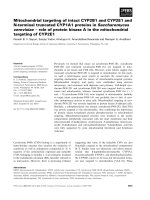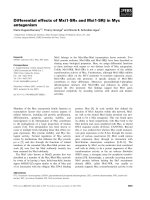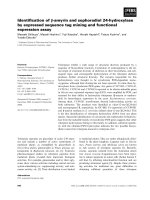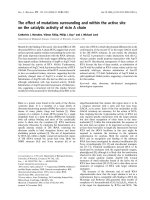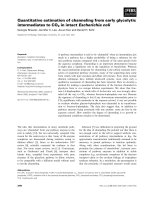Báo cáo khoa học: "Generalized Encoding of Description Spaces and its Application to Typed Feature Structures" potx
Bạn đang xem bản rút gọn của tài liệu. Xem và tải ngay bản đầy đủ của tài liệu tại đây (107.03 KB, 8 trang )
Generalized Encoding of Description Spaces and its Application to Typed
Feature Structures
Gerald Penn
Department of Computer Science
University of Toronto
10 King's College Rd.
Toronto M5S 3G4, Canada
Abstract
This paper presents a new formalization of
a unification- or join-preserving encoding
of partially ordered sets that more essen-
tially captures what it means for an en-
coding to preserve joins, generalizing the
standard definition in AI research. It then
shows that every statically typable ontol-
ogy in the logic of typed feature struc-
tures can be encoded in a data structure
of fixed size without the need for resizing
or additional union-find operations. This
is important for any grammar implemen-
tation or development system based on
typed feature structures, as it significantly
reduces the overhead of memory manage-
ment and reference-pointer-chasing dur-
ing unification.
1 Motivation
The logic of typed feature structures (Carpenter,
1992) has been widely used as a means of formaliz-
ing and developing natural language grammars that
support computationally efficient parsing, genera-
tion and SLD resolution, notably grammars within
the Head-driven Phrase Structure Grammar (HPSG)
framework, as evidenced by the recent successful
development of the LinGO reference grammar for
English (LinGO, 1999). These grammars are for-
mulated over a finite vocabulary of features and par-
tially ordered types, in respect of constraints called
appropriateness conditions. Appropriateness speci-
fies, for each type, all and only the features that take
values in feature structures of that type, along with
adj noun
CASE:case
nom acc plus minus subst
case bool head
MOD:bool
PRD:bool
Figure 1: A sample type system with appropriate-
ness conditions.
the types of values (value restrictions) those feature
values must have. In Figure 1,
1
for example, all
head-typed TFSs must have bool-typed values for
the features MOD and PRD, and no values for any
other feature.
Relative to data structures like arrays or logical
terms, typed feature structures (TFSs) can be re-
garded as an expressive refinement in two different
ways. First, they are typed, and the type system al-
lows for subtyping chains of unbounded depth. Fig-
ure 1 has a chain of length
from to noun. Point-
ers to arrays and logical terms can only monoton-
ically “refine” their (syntactic) type from unbound
(for logical terms, variables) to bound. Second, al-
though all the TFSs of a given type have the same
features because of appropriateness, a TFS may ac-
quire more features when it promotes to a subtype. If
a head-typed TFS promotes to noun in the type sys-
tem above, for example, it acquires one extra case-
valued feature, CASE. When a subtype has two or
1
In this paper, Carpenter's (1992) convention of using
as
the most general type, and depicting subtypes above their su-
pertypes is used.
Computational Linguistics (ACL), Philadelphia, July 2002, pp. 64-71.
Proceedings of the 40th Annual Meeting of the Association for
more incomparable supertypes, a TFS can also mul-
tiply inherit features from other supertypes when it
promotes.
The overwhelmingly most prevalent operation
when working with TFS-based grammars is unifica-
tion, which corresponds mathematically to finding
a least upper bound or join. The most common in-
stance of unification is the special case in which a
TFS is unified with the most general TFS that satis-
fies a description stated in the grammar. This special
case can be decomposed at compile-time into more
atomic operations that (1) promote a type to a sub-
type, (2) bind a variable, or (3) traverse a feature
path, according to the structure of the description.
TFSs actually possess most of the properties of
fixed-arity terms when it comes to unification, due
to appropriateness. Nevertheless, unbounded sub-
typing chains and acquiring new features conspire
to force most internal representations of TFSs to per-
form extra work when promoting a type to a subtype
to earn the expressive power they confer. Upon be-
ing repeatedly promoted to new subtypes, they must
be repeatedly resized or repeatedly referenced with
a pointer to newly allocated representations, both of
which compromise locality of reference in memory
and/or involve pointer-chasing. These costs are sig-
nificant.
Because appropriateness involves value restric-
tions, simply padding a representation with some ex-
tra space for future features at the outset must guar-
antee a proper means of filling that extra space with
the right value when it is used. Internal representa-
tions that lazily fill in structure must also be wary
of the common practice in description languages of
binding a variable to a feature value with a scope
larger than a single TFS — for example, in sharing
structure between a daughter category and a mother
category in a phrase structure rule. In this case, the
representation of a feature's value must also be in-
terpretable independent of its context, because two
separate TFSs may refer to that variable.
These problems are artifacts of not using a rep-
resentation which possesses what in knowledge rep-
resentation is known as a join-preserving encoding
of a grammar's TFSs — in other words, a repre-
sentation with an operation that naturally behaves
like TFS-unification. The next section presents the
standard definition of join-preserving encodings and
provides a generalization that more essentially cap-
tures what it means for an encoding to preserve
joins. Section 3 formalizes some of the defining
characteristics of TFSs as they are used in com-
putational linguistics. Section 4 shows that these
characteristics quite fortuitously agree with what
is required to guarantee the existence of a join-
preserving encoding of TFSs that needs no resizing
or extra referencing during type promotion. Sec-
tion 5 then shows that a generalized encoding exists
in which variable-binding scope can be larger than a
single TFS — a property no classical encoding has.
Earlier work on graph unification has focussed on
labelled graphs with no appropriateness, so the cen-
tral concern was simply to minimize structure copy-
ing. While this is clearly germane to TFSs, appro-
priateness creates a tradeoff among copying, the po-
tential for more compact representations, and other
memory management issues such as locality of ref-
erence that can only be optimized empirically and
relative to a given grammar and corpus (a recent ex-
ample of which can be found in Callmeier (2001)).
While the present work is a more theoretical consid-
eration of how unification in one domain can sim-
ulate unification in another, the data structure de-
scribed here is very much motivated by the encod-
ing of TFSs as Prolog terms allocated on a contigu-
ous WAM-style heap. In that context, the emphasis
on fixed arity is really an attempt to avoid copying,
and lazily filling in structure is an attempt to make
encodings compact, but only to the extent that join
preservation is not disturbed. While this compro-
mise solution must eventually be tested on larger and
more diverse grammars, it has been shown to reduce
the total parsing time of a large corpus on the ALE
HPSG benchmark grammar of English (Penn, 1993)
by a factor of about 4 (Penn, 1999).
2 Join-Preserving Encodings
We may begin with a familiar definition from dis-
crete mathematics:
Definition 1 Given two partial orders
and
, a function is an order-
embedding iff, for every , iff
.
An order-embedding preserves the behavior of the
order relation (for TFS type systems, subtyping;
f
Figure 2: An example order-embedding that cannot
translate least upper bounds.
for TFSs themselves, subsumption) in the encoding
codomain. As shown in Figure 2, however, order
embeddings do not always preserve operations such
as least upper bounds. The reason is that the im-
age of
may not be closed under those operations
in the codomain. In fact, the codomain could pro-
vide joins where none were supposed to exist, or, as
in Figure 2, no joins where one was supposed to ex-
ist. Mellish (1991; 1992) was the first to formulate
join-preserving encodings correctly, by explicitly re-
quiring this preservation. Let us write
for the
join of and in partial order .
Definition 2 A partial order is bounded
complete (BCPO) iff every set of elements with a
common upper bound has a least upper bound.
Bounded completeness ensures that unification or
joins are well-defined among consistent types.
Definition 3 Given two BCPOs, and ,
is a classical join-preserving encoding of
into iff:
injectivity is an injection,
zero preservation
2
iff
, and
join homomorphism
, where they exist.
Join-preserving encodings are automatically order-
embeddings because iff .
There is actually a more general definition:
Definition 4 Given two BCPOs, and ,
is a (generalized) join-preserving
encoding of into iff:
totality for all , ,
disjointness iff ,
2
We use the notation
to mean is undefined, and
to mean is defined.
f
Figure 3: A non-classical join-preserving encod-
ing between BCPOs for which no classical join-
preserving encoding exists.
zero preservation for all and
, iff , and
join homomorphism for all and
, , where they exist.
When maps elements of to singleton sets in ,
then reduces to a classical join-preserving encod-
ing. It is not necessary, however, to require that only
one element of represent an element of , pro-
vided that it does not matter which representative we
choose at any given time. Figure 3 shows a gener-
alized join-preserving encoding between two partial
orders for which no classical encoding exists. There
is no classical encoding of into because no three
elements can be found in that pairwise unify to
a common join. A generalized encoding exists be-
cause we can choose three potential representatives
for : one ( ) for unifying the representatives of
and , one ( ) for unifying the representatives of
and , and one ( ) for unifying the representatives of
and . Notice that the set of representatives for
must be closed under unification.
Although space does not permit here, this gener-
alization has been used to prove that well-typing,
an alternative interpretation of appropriateness, is
equivalent in its expressive power to the interpreta-
tion used here (called total well-typing; Carpenter,
1992); that multi-dimensional inheritance (Erbach,
1994) adds no expressive power to any TFS type sys-
tem; that TFS type systems can encode systemic net-
works in polynomial space using extensional types
(Carpenter, 1992); and that certain uses of paramet-
ric typing with TFSs also add no expressive power
to the type system (Penn, 2000).
3 TFS Type Systems
There are only a few common-sense restrictions we
need to place on our type systems:
Definition 5 A TFS type system consists of a finite
BCPO of types, , a finite set of features Feat,
and a partial function,
such that, for every F :
(Feature Introduction) there is a
type F such that:
F F , and for all ,
if F , then F , and
(Upward Closure / Right Monotonicity) if
F and , then F
and F F .
The function Approp maps a feature and type to the
value restriction on that feature when it is appropri-
ate to that type. If it is not appropriate, then Ap-
prop is undefined at that pair. Feature introduction
ensures that every feature has a least type to which
it is appropriate. This makes description compila-
tion more efficient. Upward closure ensures that
subtypes inherit their supertypes' features, and with
consistent value restrictions. The combination of
these two properties allows us to annotate a BCPO of
types with features and value restrictions only where
the feature is introduced or the value restriction is re-
fined, as in Figure 1.
A very useful property for type systems to have
is static typability. This means that if two TFSs
that are well-formed according to appropriateness
are unifiable, then their unification is automatically
well-formed as well — no additional work is neces-
sary.
Theorem 1 (Carpenter, 1992) An appropriateness
specification is statically typable iff, for all types
such that , and all F :
F
F if F and
F F
F if only F
F if only F
unrestricted otherwise
(head representation)
(MOD representation)
(PRD representation)
Figure 4: A fixed array representation of the TFS in
Figure 5.
head
MOD plus
PRD plus
Figure 5: A TFS of type head from the type system
in Figure 1.
Not all type systems are statically typable, but a type
system can be transformed into an equivalent stati-
cally typable type system plus a set of universal con-
straints, the proof of which is omitted here. In lin-
guistic applications, we normally have a set of uni-
versal constraints anyway for encoding principles of
grammar, so it is easy and computationally inexpen-
sive to conduct this transformation.
4 Static Encodability
As mentioned in Section 1, what we want is an en-
coding of TFSs with a notion of unification that nat-
urally corresponds to TFS-unification. As discussed
in Section 3, static typability is something we can
reasonably guarantee in our type systems, and is
therefore something we expect to be reflected in our
encodings — no extra work should be done apart
from combining the types and recursing on feature
values. If we can ensure this, then we have avoided
the extra work that comes with resizing or unneces-
sary referencing and pointer-chasing.
As mentioned above, what would be best from the
standpoint of memory management is simply a fixed
array of memory cells, padded with extra space to
accommodate features that might later be added. We
will call these frames. Figure 4 depicts a frame for
the head-typed TFS in Figure 5. In a frame, the rep-
resentation of the type can either be (1) a bit vec-
tor encoding the type,
3
or (2) a reference pointer
3
Instead of a bit vector, we could also use an index into a
table if least upper bounds are computed by table look-up.
to another frame. If backtracking is supported in
search, changes to the type representation must be
trailed. For each appropriate feature, there is also a
pointer to a frame for that feature's value. There are
also additional pointers for future features (for head,
CASE) that are grounded to some distinguished value
indicating that they are unused — usually a circu-
lar reference to the referring array position. Cyclic
TFSs, if they are supported, would be represented
with cyclic (but not 1-cyclic) chains of pointers.
Frames can be implemented either directly as ar-
rays, or as Prolog terms. In Prolog, the type rep-
resentation could either be a term-encoding of the
type, which is guaranteed to exist for any finite
BCPO (Mellish, 1991; Mellish, 1992), or in ex-
tended Prologs, another trailable representation such
as a mutable term (Aggoun and Beldiceanu, 1990)
or an attributed value (Holzbaur, 1992). Padding the
representation with extra space means using a Pro-
log term with extra arity. A distinguished value for
unused arguments must then be a unique unbound
variable.
4
4.1 Restricting the Size of Frames
At first blush, the prospect of adding as many extra
slots to a frame as there could be extra features in
a TFS sounds hopelessly unscalable to large gram-
mars. While recent experience with LinGO (1999)
suggests a trend towards modest increases in num-
bers of features compared to massive increases in
numbers of types as grammars grow large, this is
nevertheless an important issue to address. There
are two discrete methods that can be used in combi-
nation to reduce the required number of extra slots:
Definition 6 Given a finite BCPO,
, the set of
modules of is the finest partition of ,
, such that (1) each is upward-closed
(with respect to subtyping), and (2) if two types have
a least upper bound, then they belong to the same
module.
Trivially, if a feature is introduced at a type in one
module, then it is not appropriate to any type in any
other module. As a result, a frame for a TFS only
needs to allow for the features appropriate to the
4
Prolog terms require one additional unbound variable per
TFS (sub)termin order to preserve the intensionalityof the logic
— unlike Prolog terms, structurally identical TFS substructures
are not identical unless explicitly structure-shared.
a b c
d
F:
e
G:
f
H:
Figure 6: A type system with three features and a
three-colorable feature graph.
module of its type. Even this number can normally
be reduced:
Definition 7 The feature graph,
, of module
is an undirected graph, whose vertices corre-
spond to the features introduced in
, and in which
there is an edge, , iff and are appropriate
to a common maximally specific type in .
Proposition 1 The least number of feature slots re-
quired for a frame of any type in is the least
for which is -colorable.
There are type systems, of course, for which mod-
ularization and graph-coloring will not help. Fig-
ure 6, for example, has one module, three features,
and a three-clique for a feature graph. There are
statistical refinements that one could additionally
make, such as determining the empirical probability
that a particular feature will be acquired and electing
to pay the cost of resizing or referencing for improb-
able features in exchange for smaller frames.
4.2 Correctness of Frames
With the exception of extra slots for unused feature
values, frames are clearly isomorphic in their struc-
ture to the TFSs they represent. The implementation
of unification that we prefer to avoid resizing and
referencing is to (1) find the least upper bound of
the types of the frames being unified, (2) update one
frame's type to the least upper bound, and point the
other's type representation to it, and (3) recurse on
respective pairs of feature values. The frame does
not need to be resized, only the types need to be ref-
erenced, and in the special case of promoting the
type of a single TFS to a subtype, the type only
needs to be trailed. If cyclic TFSs are not supported,
then acyclicity must also be enforced with an occurs-
check.
The correctness of frames as a join-preserving en-
coding of TFSs thus depends on being able to make
sense of the values in these unused positions. The
c
F:a
a b
Figure 7: A type system that introduces a feature at
a join-reducible type.
head
MOD plus
PRD bool
Figure 8: A TFS of type head in which one feature
value is a most general satisfier of its feature's value
restriction.
problem is that features may be introduced at join-
reducible types, as in Figure 7. There is only one
module, so the frames for a and b must have a slot
available for the feature F. When an a-typed TFS
unifies with a b-typed TFS, the result will be of type
c, so leaving the slot marked unused after recursion
would be incorrect — we would need to look in a
table to see what value to assign it. An alternative
would be to place that value in the frames for a and
b from the beginning. But since the value itself must
be of type a in the case of Figure 7, this strategy
would not yield a finite representation.
The answer to this conundrum is to use a distin-
guished circular reference in a slot iff the slot is ei-
ther unused or the value it contains is (1) the most
general satisfier of the value restriction of the fea-
ture it represents and (2) not structure-shared with
any other feature in the TFS.
5
During unification, if
one TFS is a circular reference, and the other is not,
the circular reference is referenced to the other. If
both values are circular references, then one is ref-
erenced to the other, which remains circular. The
feature structure in Figure 8, for example, has the
frame representation shown in Figure 9. The PRD
value is a TFS of type bool, and this value is not
shared with any other structure in the TFS. If the
values of MOD and PRD are both bool-typed, then if
5
The sole exception is a TFS of type
, which by definition
belongs to no module and has no features. Its representation is
a distinguished circular reference, unless two or more feature
values share a single
-typed TFS value, in which case one is
a circular reference and the rest point to it. The circular one
can be chosen canonically to ensure that the encoding is still
classical.
(head representation)
(MOD representation)
Figure 9: The frame for Figure 8.
they are shared (Figure 10), they do not use circu-
head
MOD bool
PRD
Figure 10: A TFS of type head in which both fea-
ture values are most general satisfiers of the value
restrictions, but they are shared.
lar references (Figure 11), and if they are not shared
(Figure 12), both of them use a different circular ref-
erence (Figure 13).
With this convention for circular references,
frames are a classical join-preserving encoding of
the TFSs of any statically typable type system. Al-
though space does not permit a complete proof here,
the intuition is that (1) most general satisfiers of
value restrictions necessarily subsume every other
value that a totally well-typed TFS could take at that
feature, and (2) when features are introduced, their
initial values are not structure-shared with any other
substructure. Static typability ensures that value re-
strictions unify to yield value restrictions, except in
the final case of Theorem 1. The following lemma
deals with this case:
Lemma 1 If Approp is statically typable, ,
and for some F , F and
F , then either F or
(head representation)
(MOD/PRD representation)
-
Figure 11: The frame for Figure 10.
head
MOD bool
PRD bool
Figure 12: A TFS of type head in which both fea-
ture values are most general satisfiers of the value
restrictions, and they are not shared.
(head representation)
Figure 13: The frame for Figure 12.
F F F .
Proof: Suppose F . Then
F . F and
F , so F and F .
So there are three cases to consider:
Intro F : then the result trivially holds.
Intro F but Intro F (or by symmetry, the
opposite): then we have the situation in Figure 14.
It must be that F , so by static
typability, the lemma holds.
Intro F and Intro F : and
F , so and F are con-
sistent. By bounded completeness, F
and F . By upward closure,
F F and by static typability,
F F F F .
Furthermore, F ; thus by
static typability the lemma holds.
This lemma is very significant in its own right —
it says that we know more than Carpenter's Theo-
rem 1. An introduced feature's value restriction can
always be predicted in a statically typable type sys-
tem. The lemma implicitly relies on feature intro-
F
Figure 14: The second case in the proof of Lemma 1.
F:
F: F:
Figure 15: A statically typable “type system” that
multiply introduces F at join-reducible elements
with different value restrictions.
duction, but in fact, the result holds if we allow for
multiple introducing types, provided that all of them
agree on what the value restriction for the feature
should be. Would-be type systems that multiply in-
troduce a feature at join-reducible elements (thus re-
quiring some kind of distinguished-value encoding),
disagree on the value restriction, and still remain
statically typable are rather difficult to come by, but
they do exist, and for them, a frame encoding will
not work. Figure 15 shows one such example. In
this signature, the unification:
s
F d
t
F b
does not exist, but the unification of their frame en-
codings must succeed because the -typed TFS's F
value must be encoded as a circular reference. To
the best of the author's knowledge, there is no fixed-
size encoding for Figure 15.
5 Generalized Term Encoding
In practice, this classical encoding is not good for
much. Description languages typically need to bind
variables to various substructures of a TFS, , and
then pass those variables outside the substructures of
where they can be used to instantiate the value of
another feature structure's feature, or as arguments
to some function call or procedural goal. If a value
in a single frame is a circular reference, we can prop-
erly understand what that reference encodes with the
above convention by looking at its context, i.e., the
type. Outside the scope of that frame, we have no
way of knowing which feature's value restriction it
is supposed to encode.
Introduced feature
has variable encoding
variable
binding
Figure 16: A pictorial overview of the generalized
encoding.
A generalized term encoding provides an elegant
solution to this problem. When a variable is bound
to a substructure that is a circular reference, it can
be filled in with a frame for the most general satis-
fier that it represents and then passed out of context.
Having more than one representative for the original
TFS is consistent, because the set of representatives
is closed under this filling operation.
A schematic overview of the generalized encod-
ing is in Figure 16. Every set of frames that encode a
particular TFS has a least element, in which circular
references are always opted for as introduced fea-
ture values. This is the same element as the classical
encoding. It also has a greatest element, in which
every unused slot still has a circular reference, but
all unshared most general satisfiers are filled in with
frames. Whenever we bind a variable to a substruc-
ture of a TFS, filling pushes the TFS's encoding up
within the same set to some other encoding. As a
result, at any given point in time during a computa-
tion, we do not exactly know which encoding we are
using to represent a given TFS. Furthermore, when
two TFSs are unified successfully, we do not know
exactly what the result will be, but we do know that it
falls inside the correct set of representatives because
there is at least one frame with circular references
for the values of every newly introduced feature.
6 Conclusion
Simple frames with extra slots and a convention for
filling in feature values provide a join-preserving en-
coding of any statically typable type system, with
no resizing and no referencing beyond that of type
representations. A frame thus remains stationary
in memory once it is allocated. A generalized en-
coding, moreover, is robust to side-effects such as
extra-logical variable-sharing. Frames have many
potential implementations, including Prolog terms,
WAM-style heap frames, or fixed-sized records.
References
A. Aggoun and N. Beldiceanu. 1990. Time stamp techniques
for the trailed data in constraint logic programming systems.
In S. Bourgault and M. Dincbas, editors, Programmation en
Logique, Actes du 8eme Seminaire, pages 487–509.
U. Callmeier. 2001. Efficient parsing with large-scale unifica-
tion grammars. Master's thesis, Universitaet des Saarlandes.
B. Carpenter. 1992. The Logic of Typed Feature Structures.
Cambridge.
G. Erbach. 1994. Multi-dimensional inheritance. In Proceed-
ings of KONVENS 94. Springer.
C. Holzbaur. 1992. Metastructures vs. attributed variables in
the context of extensible unification. In M. Bruynooghe and
M. Wirsing, editors, Programming Language Implementa-
tion and Logic Programming, pages 260–268. Springer Ver-
lag.
LinGO. 1999. The LinGO grammar and lexicon. Available
on-line at .
C. Mellish. 1991. Graph-encodable description spaces. Tech-
nical report, University of Edinburgh Department of Artifi-
cial Intelligence. DYANA Deliverable R3.2B.
C. Mellish. 1992. Term-encodable description spaces. In D.R.
Brough, editor, Logic Programming: New Frontiers, pages
189–207. Kluwer.
G. Penn. 1993. The ALE HPSG benchmark gram-
mar. Available on-line at />gpenn/ale.html.
G. Penn. 1999. An optimized Prolog encoding of typed feature
structures. In Proceedings of the 16th International Confer-
ence on Logic Programming (ICLP-99), pages 124–138.
G. Penn. 2000. The Algebraic Structure of Attributed Type
Signatures. Ph.D. thesis, Carnegie Mellon University.
